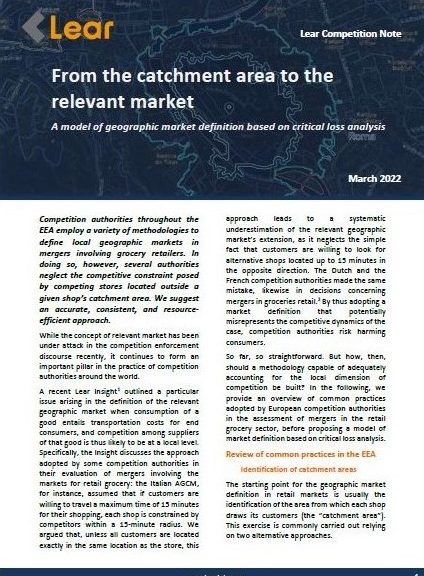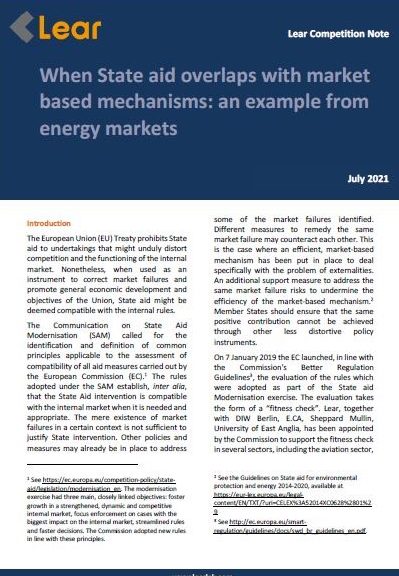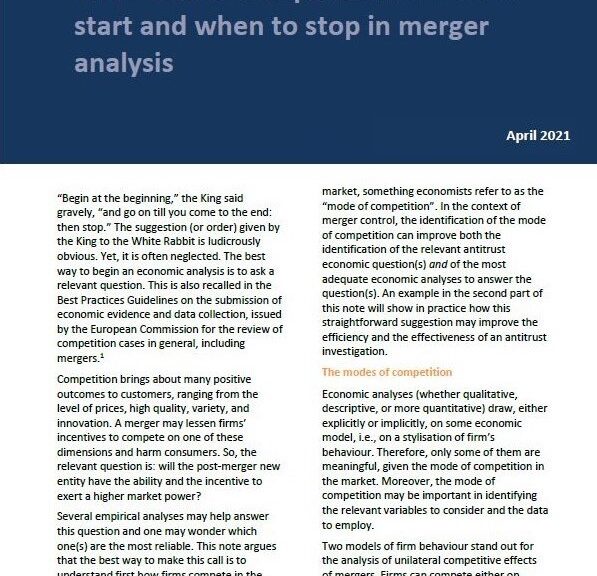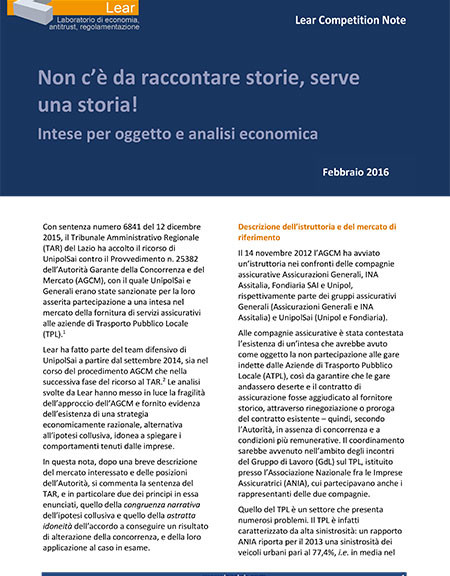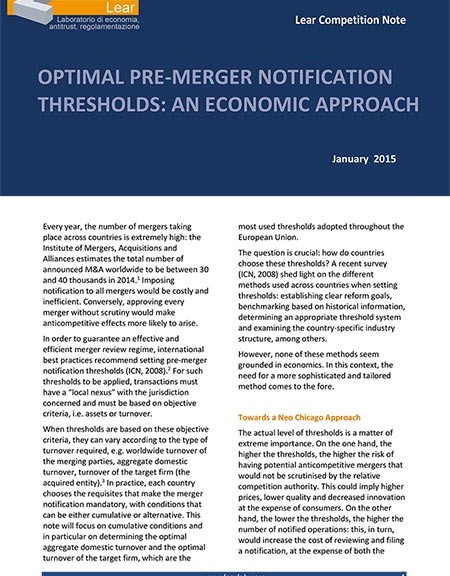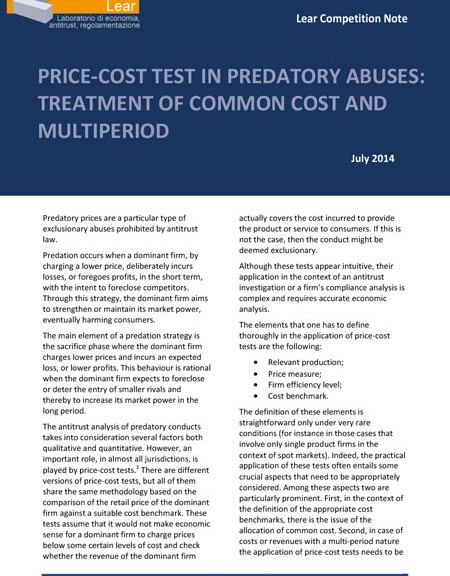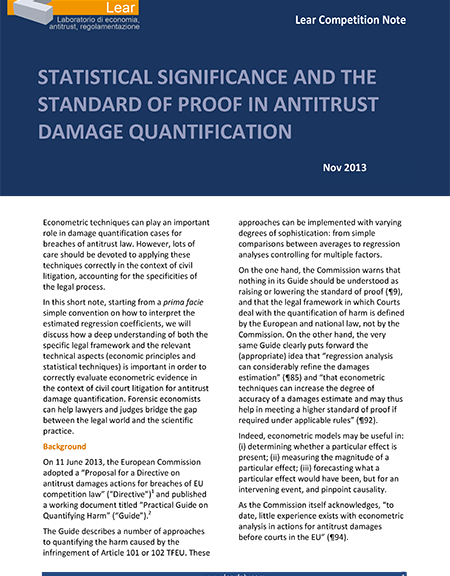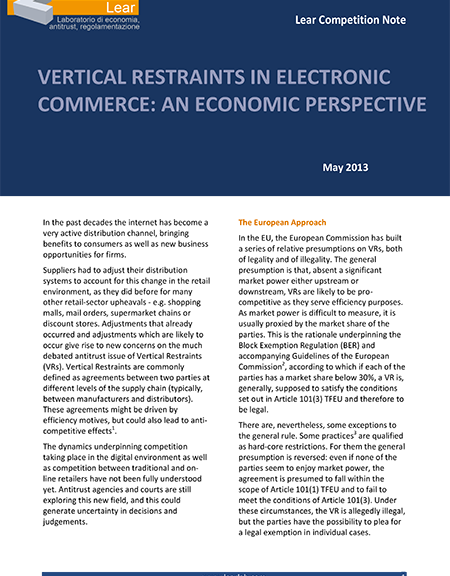Competition authorities throughout the EEA employ a variety of methodologies to define local geographic markets in mergers involving grocery retailers. In doing so, however, several authorities neglect the competitive constraint posed by competing stores located outside a given shop’s catchment area. We suggest an accurate, consistent, and resource-efficient approach.
Archives
When State aid overlaps with market based mechanisms: an example from energy markets
The Lear Competition Note (LCN) discusses the existing literature on the interaction between State aid intervention that incentivizes the investment in decarbonisation technologies and the market-based mechanism relying on the European Union Emission Trading System (ETS). Now in its fourth phase, the EU ETS is often considered the most effective policy to reduce greenhouse gas emissions.
The mere existence of market failures in a certain context is not sufficient to justify State intervention. Other policies and measures may already be in place to address some of the market failures identified. Different measures to remedy the same market failure may counteract each other. The LCN discusses to what extent State aid intervention might be needed and appropriate to achieve climate neutrality, when Member States already rely on the ETS.
The mode of competition: where to start and when you stop in merger analysis
“The best way to begin an economic analysis is to ask a relevant question. In a merger analysis the relevant question is: will the post-merger new entity have the ability and the incentive to exert a higher market power? But which analyses are best suited to answer these questions? This note argues that the best way to make this call is to understand first how firms compete in the market, something economists refer to as the “mode of competition”. In the context of merger control, the identification of the mode of competition can improve both the identification of the relevant antitrust economic question(s) and of the most adequate economic analyses to answer the question(s).”
Aiuti di Stato e analisi economica: Il caso dei decoder
Con la sentenza n. 2897/2016 il Tribunale di Roma ha accolto il ricorso di Mediaset contro il provvedimento con cui il Ministero dello Sviluppo Economico aveva ordinato la restituzione di un aiuto di stato illegale, di cui l’azienda aveva beneficiato nel biennio 2004-2005. Nel dicembre 2003, in particolare, il governo italiano aveva approvato il finanziamento del passaggio dalla trasmissione televisiva analogica a quella digitale, corrispondendo un contributo in euro per ogni utente che avesse acquistato un decoder digitale terrestre (DT).
La decisione del Tribunale ha richiesto complesse valutazioni economiche e l’utilizzo di metodi quantitativi sofisticati, analisi che costituiscono un elemento di novità nell’applicazione delle norme sugli aiuti di stato. Tuttavia, questo approccio nel fondare le decisioni in materia su una solida analisi economica riflette sempre più un’esigenza avvertita da molti.
Questa LCN sottolinea l’importanza di utilizzare valutazioni di natura tecnica e di tecniche sofisticate di analisi empirica nella giurisprudenza degli aiuti di stato, raccontando nello specifico il caso dei decoder.
Non c’è da raccontare storie, serve una storia! Intese per oggetto e analisi economica
La LCN commenta la recente sentenza con cui il Tribunale Amministrativo Regionale del Lazio ha accolto il ricorso di UnipolSai contro il Provvedimento n. 25382 dell’Autorità Garante della Concorrenza e del Mercato.
La LCN si focalizza su due dei principi enunciati nella sentenza, quello della congruenza narrativa dell’ipotesi collusiva e quello della astratta idoneità dell’accordo a conseguire un risultato di alterazione della concorrenza.
Optimal pre-merger notification thresholds: an economic approach
The level of pre-merger notification thresholds is a matter of extreme importance to guarantee an effective and efficient merger review regime. On the one hand, the higher the thresholds the higher the risk of having potential anticompetitive mergers that might not be assessed by the relative authority. On the other hand, imposing notification to all mergers would be costly and inefficient for both the competition authority and the merging parties. This note presents an economic approach to set the optimal pre-merger notification threshold and provides some initial thoughts to fill the literature gap on the topic.
Il ruolo dell’analisi economica nella determinazione delle sanzioni per illeciti concorrenziali
Il 31 ottobre 2014 l’Autorità Garante della Concorrenza e del Mercato (AGCM) ha pubblicato le Linee Guida sulla modalità di determinazione delle sanzioni pecuniarie irrogate nel caso di violazioni di norme concorrenziali. La presente nota descrive alcuni elementi di novità e illustra come le Linee Guida suggeriscono un più ampio ruolo dell’analisi economica, anche ai fini della quantificazione dell’importo delle sanzioni.
Price-cost test in predatory abuses: treatment of common cost and multiperiod
Predatory prices are a particular type of exclusionary abuse whereby a dominant firm incurs short-term losses by charging a lower price deliberately with the intent to foreclose competitors. The antitrust analysis of predatory conduct entails the application of price-cost tests. These tests are based on the comparison of the retail price of a dominant firm against a suitable cost benchmark. Although these tests appear intuitive, their application in the context of antitrust investigation or of a firm’s compliance analysis is complex and requires accurate economic evaluation. This note describes the crucial aspects that need to be considered in the implementation of the price-cost tests.
Statistical significance and the standard of proof in antitrust damage quantification
Econometric techniques can play an important role in damage quantification cases regarding breaches of antitrust law. In this short note, starting from a prima facie simple convention on how to interpret the estimated regression coefficients, we will discuss how a deep understanding of both the specific legal framework and the relevant technical aspects is important in order to evaluate econometric evidence correctly in the context of civil court litigation for antitrust damage quantification.
Vertical Restraints in Electronic Commerce: an economic perspective
Vertical Restraints (VRs) are commonly defined as agreements between two parties at different levels of the supply chain. These agreements might be driven by efficiency reasons but could also lead to anti-competitive effects. In the past decade, the development of electronic commerce has raised new issues concerning the dynamics underpinning competition in the digital environment as well as competition between traditional and on-line retailers. Through the analysis of the Pierre Fabre Dermo-Cosmétique case, this note seeks to outline a different approach in the assessment of VRs in electronic markets and analyses some critical issues that are often neglected.

